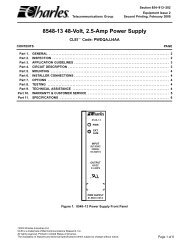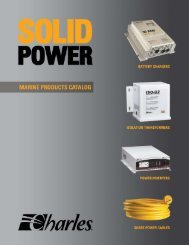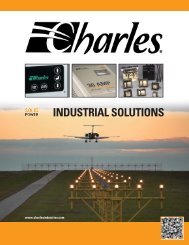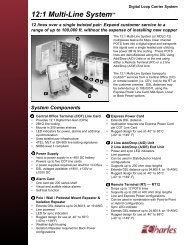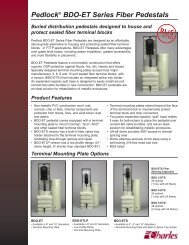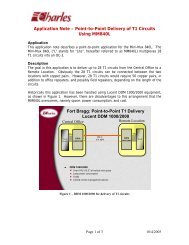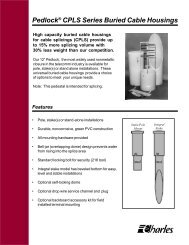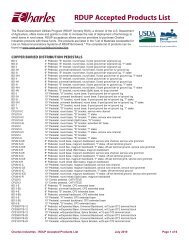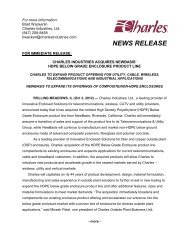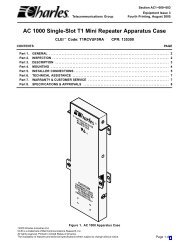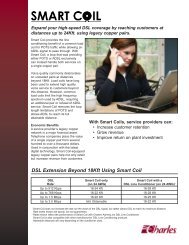Manual - Charles Industries, Ltd.
Manual - Charles Industries, Ltd.
Manual - Charles Industries, Ltd.
Create successful ePaper yourself
Turn your PDF publications into a flip-book with our unique Google optimized e-Paper software.
Issue 1 Print 4<br />
HQ-CHARGER<br />
MARINE ELECTRONIC ABS BATTERY CHARGER<br />
LT–5000HQ–1<br />
5000 SP SERIES INSTALLATION<br />
INSTRUCTIONS & OWNER’S MANUAL<br />
<strong>Charles</strong> <strong>Industries</strong>, <strong>Ltd</strong>. All rights reserved. Printed in the United States of America.
LT–5000HQ–1 Issue 1 Print 4<br />
Contents<br />
INTRODUCING... THE HQ SERIES ABS CHARGER . . . . . . . . . . . . . . . . . . . . . . . . . . . . . . . . . . . . . . . . . . . . . . . . . . . 3<br />
<strong>Manual</strong> Purpose . . . . . . . . . . . . . . . . . . . . . . . . . . . . . . . . . . . . . . . . . . . . . . . . . . . . . . . . . . . . . . . . . . . . . . . . . . . . . . . 4<br />
IMPORTANT SAFETY INSTRUCTIONS . . . . . . . . . . . . . . . . . . . . . . . . . . . . . . . . . . . . . . . . . . . . . . . . . . . . . . . . . . . . . . 4<br />
Environmental Precaution . . . . . . . . . . . . . . . . . . . . . . . . . . . . . . . . . . . . . . . . . . . . . . . . . . . . . . . . . . . . . . . . . . . . . . 4<br />
Application Precaution . . . . . . . . . . . . . . . . . . . . . . . . . . . . . . . . . . . . . . . . . . . . . . . . . . . . . . . . . . . . . . . . . . . . . . . . . 4<br />
Damaged Unit Precaution . . . . . . . . . . . . . . . . . . . . . . . . . . . . . . . . . . . . . . . . . . . . . . . . . . . . . . . . . . . . . . . . . . . . . . 4<br />
Disassembly Precaution . . . . . . . . . . . . . . . . . . . . . . . . . . . . . . . . . . . . . . . . . . . . . . . . . . . . . . . . . . . . . . . . . . . . . . . 4<br />
Maintenance/Cleaning Precaution . . . . . . . . . . . . . . . . . . . . . . . . . . . . . . . . . . . . . . . . . . . . . . . . . . . . . . . . . . . . . . 4<br />
Personal Safety Precautions . . . . . . . . . . . . . . . . . . . . . . . . . . . . . . . . . . . . . . . . . . . . . . . . . . . . . . . . . . . . . . . . . . . 4<br />
Preparing to Charge Precautions . . . . . . . . . . . . . . . . . . . . . . . . . . . . . . . . . . . . . . . . . . . . . . . . . . . . . . . . . . . . . . . 5<br />
Connecting to the Battery Outside the Boat Precautions . . . . . . . . . . . . . . . . . . . . . . . . . . . . . . . . . . . . . . . . . 5<br />
Grounding Precautions . . . . . . . . . . . . . . . . . . . . . . . . . . . . . . . . . . . . . . . . . . . . . . . . . . . . . . . . . . . . . . . . . . . . . . . . 5<br />
INSTALLING THE HQ SERIES ABS CHARGER . . . . . . . . . . . . . . . . . . . . . . . . . . . . . . . . . . . . . . . . . . . . . . . . . . . . . . . 5<br />
Verifying Proper Battery/Charger Type . . . . . . . . . . . . . . . . . . . . . . . . . . . . . . . . . . . . . . . . . . . . . . . . . . . . . . . . . . 5<br />
Choosing Mounting Location . . . . . . . . . . . . . . . . . . . . . . . . . . . . . . . . . . . . . . . . . . . . . . . . . . . . . . . . . . . . . . . . . . . 6<br />
Choosing Mounting Hardware . . . . . . . . . . . . . . . . . . . . . . . . . . . . . . . . . . . . . . . . . . . . . . . . . . . . . . . . . . . . . . . . . . 6<br />
Mounting the HQ Series ABS Charger . . . . . . . . . . . . . . . . . . . . . . . . . . . . . . . . . . . . . . . . . . . . . . . . . . . . . . . . . . . 6<br />
Mounting the Splash Guard . . . . . . . . . . . . . . . . . . . . . . . . . . . . . . . . . . . . . . . . . . . . . . . . . . . . . . . . . . . . . . . . . . . . 6<br />
Choosing Electrical Wiring Hardware . . . . . . . . . . . . . . . . . . . . . . . . . . . . . . . . . . . . . . . . . . . . . . . . . . . . . . . . . . . 6<br />
Choosing Wire Gauge . . . . . . . . . . . . . . . . . . . . . . . . . . . . . . . . . . . . . . . . . . . . . . . . . . . . . . . . . . . . . . . . . . . . . . . . . 6<br />
Making AC Connections on Terminal Block 1 (TB1) . . . . . . . . . . . . . . . . . . . . . . . . . . . . . . . . . . . . . . . . . . . . . . 7<br />
Making DC Connections on Terminal Block 2 (TB2) . . . . . . . . . . . . . . . . . . . . . . . . . . . . . . . . . . . . . . . . . . . . . . 8<br />
Wirinig Notes . . . . . . . . . . . . . . . . . . . . . . . . . . . . . . . . . . . . . . . . . . . . . . . . . . . . . . . . . . . . . . . . . . . . . . . . . . . . . . . . . 10<br />
Closing the Cover . . . . . . . . . . . . . . . . . . . . . . . . . . . . . . . . . . . . . . . . . . . . . . . . . . . . . . . . . . . . . . . . . . . . . . . . . . . . 10<br />
Applying Power . . . . . . . . . . . . . . . . . . . . . . . . . . . . . . . . . . . . . . . . . . . . . . . . . . . . . . . . . . . . . . . . . . . . . . . . . . . . . . 10<br />
OPERATING THE HQ SERIES ABS CHARGER . . . . . . . . . . . . . . . . . . . . . . . . . . . . . . . . . . . . . . . . . . . . . . . . . . . . . . 11<br />
Proper Operation . . . . . . . . . . . . . . . . . . . . . . . . . . . . . . . . . . . . . . . . . . . . . . . . . . . . . . . . . . . . . . . . . . . . . . . . . . . . . 11<br />
Changing Internal Fuses . . . . . . . . . . . . . . . . . . . . . . . . . . . . . . . . . . . . . . . . . . . . . . . . . . . . . . . . . . . . . . . . . . . . . . 11<br />
MAINTAINING THE HQ SERIES ABS CHARGER . . . . . . . . . . . . . . . . . . . . . . . . . . . . . . . . . . . . . . . . . . . . . . . . . . . . 11<br />
TROUBLESHOOTING THE HQ SERIES ABS CHARGER . . . . . . . . . . . . . . . . . . . . . . . . . . . . . . . . . . . . . . . . . . . . . 11<br />
WARRANTY AND CUSTOMER SERVICE . . . . . . . . . . . . . . . . . . . . . . . . . . . . . . . . . . . . . . . . . . . . . . . . . . . . . . . . . . . 12<br />
Warranty . . . . . . . . . . . . . . . . . . . . . . . . . . . . . . . . . . . . . . . . . . . . . . . . . . . . . . . . . . . . . . . . . . . . . . . . . . . . . . . . . . . . . 12<br />
Service . . . . . . . . . . . . . . . . . . . . . . . . . . . . . . . . . . . . . . . . . . . . . . . . . . . . . . . . . . . . . . . . . . . . . . . . . . . . . . . . . . . . . . 12<br />
Service Center and Repair Correspondence . . . . . . . . . . . . . . . . . . . . . . . . . . . . . . . . . . . . . . . . . . . . . . . . . . . . 12<br />
2 <strong>Charles</strong> <strong>Industries</strong>, <strong>Ltd</strong>. All rights reserved. Printed in the United States of America.
Issue 1 Print 4<br />
INTRODUCING... THE HQ SERIES ABS CHARGER<br />
LT–5000HQ–1<br />
Thank you for purchasing the HQ Series ABS Charger. The HQ Series ABS Charger is designed for hard-wired<br />
applications only. The HQ Series models convert AC power to DC charging current, to charge and maintain up to<br />
three battery banks simultaneously. All of the HQ Series ABS Charger units operate under a wide range of input<br />
voltages yet maintain a constant output, avoiding any danger of overcharging batteries. When necessary, the HQ<br />
Series units are equipped with a cooling fan and an internal temperature compensation circuit that automatically<br />
adjusts to temperature variations, extending the life of the batteries.<br />
To meet the American Bureau of Shipping standard for a battery charging system, the following features are included:<br />
A Power supply disconnecting switch, which is the ON/OFF switch located on the front cover. An LED<br />
indicator Pilot lamp, located above the ammeter. A Charging voltage adjuster, which is the potentiometer located<br />
inside the battery charger, identified by a red ink coloration. Adjustments to set the peak voltage may be<br />
done while drawing less than 1% of the rated output amperes. A Voltmeter and Ammeter, which are both located<br />
on the front cover. A means of Discharge Protection for each output bank. Current limiting constant voltage,<br />
to which the HQ series ABS battery charger is current limited to 10% over its rated amperes, while the output voltage<br />
is maintained.<br />
In addition to ABS requirements, a Charger Failure Relay (see figures 1, 2, 3 and 4) is provided. This “Form C”,<br />
10 ampere relay will annunciate when the battery charger is in operation. The contacts of the relay can be used to<br />
remotely signal whether the battery charger is or is not in operation.<br />
The various models available in the HQ Series ABS Charger product offering are listed in Table 1.<br />
Model Number<br />
AC<br />
Input<br />
Voltage<br />
Range<br />
AC<br />
Input<br />
Amps<br />
Table 1. HQ Series ABS Charger Specifications<br />
DC<br />
Output<br />
Voltage<br />
DC<br />
Output<br />
Amps<br />
CE<br />
Listed<br />
Dimensions in Inches<br />
(L X W X H)<br />
Approx<br />
Weight<br />
(Lbs)<br />
Internal Replacement<br />
Fuse Size<br />
Connection<br />
Reference<br />
AC DC<br />
12 Volt Units<br />
9Q-12255HQ-A 100–135 6 12 25 8−1/8 X 9 X 4-3/4 8.0 10A/250V* 40A/32V** Figure 1<br />
9Q-12355HQ-A 100–135 8 12 35 8−1/8 X 9 X 4-3/4 8.0 10A/250V* 40A/32V** Figure 1<br />
9Q-12455HQ-A 100–135 10 12 45 13-1/4 X 9 X 4-3/4 10.0 12A/250V* 2X30A/32V** Figure 2<br />
9Q-12555HQ-A 100–135 12 12 55 15-1/4 X 9 X 4-3/4 11.0 15A/250V* 2X40A/32V** Figure 3<br />
9Q-12655HQ-A 100–135 14 12 65 21-1/2 X 9 X 4-3/4 16.0 20A/250V* 100A/32V** Figure 4<br />
9Q-12855HQ-A 100–135 20 12 85 21-1/2 X 9 X 4-3/4 17.0 30A/250V* 100A/32V** Figure 4<br />
9Q-121055HQ-A 100–135 21 12 105 21-1/2 X 9 X 4-3/4 17.0 30A/250V* 100A/32V** Figure 4<br />
9Q-12255HQI-A 200–260 4 12 25 Yes 8−1/8 X 9 X 3-3/4 8.0 7A/250V* 40A/32V** Figure 1<br />
9Q-12355HQI-A 200–260 5 12 35 Yes 8-1/8 X 9 X 3-3/4 8.0 7A/250V* 40A/32V** Figure 1<br />
9Q-12455HQI-A 200–260 6 12 45 Yes 13−1/4 X 9 X 3-3/4 10.0 10A/250V* 2X30A/32V** Figure 2<br />
9Q-12555HQI-A 200–260 7 12 55 Yes 15-1/4 X 9 X 3-3/4 11.0 10A/250V* 2X40A/32V** Figure 3<br />
9Q-12655HQI-A 200–260 8 12 65 Yes 21-1/2 X 9 X 3-3/4 16.0 15A/250V* 100A/32V** Figure 4<br />
9Q-12855HQI-A 200–260 11 12 85 Yes 21−1/2 X 9 X 3-3/4 17.0 20A/250V* 100A/32V** Figure 4<br />
9Q-121055HQI-A 200–260 12 12 105 Yes 21−1/2 X 9 X 3-3/4 17.0 20A/250V* 100A/32V** Figure 4<br />
24 Volt Units<br />
9Q-24155HQ-A 100–135 5 24 15 8−1/8 X 9 X 4-3/4 8.0 10A/250V* 20A/32V** Figure 1<br />
9Q-24255HQ-A 100–135 10 24 25 13-1/4 X 9 X 4-3/4 10.0 12A/250V* 40A/32V** Figure 2<br />
9Q-24355HQ-A 100–135 14 24 35 15-1/4 X 9 X 4-3/4 11.0 15A/250V* 2x30A/32V** Figure 3<br />
9Q-24455HQ-A 100–135 16 24 45 15-1/4 X 9 X 4-3/4 11.0 20A/250V* 2x30A/32V** Figure 3<br />
9Q-24555HQ-A 100–135 20 24 55 21-1/2 X 9 X 4-3/4 17.0 30A/250V* 100A/32V** Figure 4<br />
9Q-24655HQ-A 100–135 21 24 65 21-1/2 X 9 X 4-3/4 17.0 30A/250V* 100A/32V** Figure 4<br />
9Q-24155HQI-A 200–260 3 24 15 Yes 8-1/8 X 9 X 4-3/4 8.0 7A/250V* 20A/32V** Figure 1<br />
9Q-24255HQI-A 200–260 6 24 25 Yes 13-1/4 X 9 X 4-3/4 10.0 10A/250V* 40A/32V** Figure 2<br />
9Q-24355HQI-A 200–260 7 24 35 Yes 15-1/4 X 9 X 4-3/4 11.0 12A/250V* 2x30A/32V** Figure 3<br />
9Q-24455HQI-A 200–260 10 24 45 Yes 15-1/4 X 9 X 4-3/4 11.0 15A/250V* 2x30A/32V** Figure 3<br />
9Q-24555HQI-A 200–260 11 24 55 Yes 21-1/2 X 9 X 4-3/4 17.0 20A/250V* 100A/32V** Figure 4<br />
9Q-24655HQI-A 200–260 12 24 65 Yes 21-1/2 X 9 X 4-3/4 17.0 20A/250V* 100A/32V** Figure 4<br />
* SLO–BLO fuse<br />
**Fast–Acting fuse<br />
<strong>Charles</strong> <strong>Industries</strong>, <strong>Ltd</strong>. All rights reserved. Printed in the United States of America.<br />
3
LT–5000HQ–1 Issue 1 Print 4<br />
<strong>Manual</strong> Purpose<br />
With your personal safety in mind, this manual lists important safety precautions first, then installation, operation,<br />
maintenance, troubleshooting and warranty and customer service information.<br />
WARNING<br />
RISK OF EXPLOSIVE GASES! WORKING IN THE VICINITY OF A LEAD ACID BATTERY IS DANGEROUS.<br />
BATTERIES GENERATE EXPLOSIVE GASES DURING NORMAL BATTERY OPERATION. THEREFORE IT<br />
IS OF UTMOST IMPORTANCE THAT EACH TIME BEFORE USING YOUR HQ SERIES ABS CHARGER<br />
YOU READ THIS MANUAL AND FOLLOW THE INSTRUCTIONS EXACTLY.<br />
To reduce risk of battery explosion, follow these instructions, those of the battery manufacturer, and the<br />
manufacturer of any equipment you use in the vicinity of the battery. Review cautionary markings on<br />
these products and on the engine.<br />
IMPORTANT SAFETY INSTRUCTIONS<br />
SAVE THESE INSTRUCTIONS. This manual contains important safety and operating instructions for<br />
the HQ Series ABS Charger. Read the entire manual before usage. Also, read all instructions and cautions for,<br />
and on, the HQ Series ABS Charger and batteries.<br />
Environmental Precaution<br />
Do not expose the HQ Series ABS Charger to rain, snow, or excessive moisture.<br />
Application Precaution<br />
These units are intended for hard-wired applications. Use of attachments not recommended or sold by <strong>Charles</strong><br />
Marine Products may result in the risk of fire, electrical shock or personal injury.<br />
Damaged Unit Precaution<br />
Do not operate the HQ Series ABS Charger if it has received a sharp blow, been dropped, or otherwise damaged.<br />
See the section in this manual on Warranty and Customer Service.<br />
Disassembly Precaution<br />
Do not disassemble the HQ Series ABS Charger. See the sections in this manual on Maintaining the HQ Series<br />
ABS Charger, Troubleshooting the HQ Series ABS Charger, and Warranty and Customer Service.<br />
Maintenance/Cleaning Precaution<br />
To reduce the risk of electrical shock, disconnect the HQ Series ABS Charger from AC power and batteries before<br />
attempting any maintenance or cleaning.<br />
Personal Safety Precautions<br />
Adhere to the following personal safety precautions when installing or working with any of the HQ Series ABS<br />
Chargers:<br />
1. Someone should be within voice range or close enough to come to your aid when you work near a battery.<br />
2. Have plenty of fresh water and soap nearby in case battery acid contacts skin, clothing, or eyes.<br />
3. Wear complete eye protection and clothing protection. Avoid touching eyes while working near a battery.<br />
4. If battery acid contacts skin or clothing, wash them immediately with soap and water. If acid enters the eye,<br />
flood the eye with cold, running water for at least ten minutes and get medical attention immediately.<br />
5. Never smoke or allow a spark or flame in the vicinity of the battery or engine.<br />
6. Do not drop a metal tool onto the battery. It may spark or short-circuit the battery or other electrical parts that<br />
can cause an explosion.<br />
7. Remove all personal metal items such as rings, bracelets, necklaces and watches when working near a lead<br />
acid battery. A battery can produce short-circuit currents high enough to weld a ring or the like to metal, causing<br />
a severe burn.<br />
4 <strong>Charles</strong> <strong>Industries</strong>, <strong>Ltd</strong>. All rights reserved. Printed in the United States of America.
Issue 1 Print 4<br />
LT–5000HQ–1<br />
8. Do not use the HQ Series ABS Charger for charging dry cell batteries that are commonly used with consumer<br />
and home appliances. These batteries may burst and cause personal injury and property damage.<br />
9. NEVER charge a frozen battery.<br />
CAUTION<br />
DO NOT attempt to charge multiple or non-recommended cell types. Other types of batteries may burst,<br />
causing personal injury and damage.<br />
Preparing to Charge Precautions<br />
Before charging a battery with the HQ Series ABS Charger, read the following precautions:<br />
1. Make sure all accessories in the boat are off.<br />
2. If the battery must be removed from the boat, always remove the grounded terminal from the battery first.<br />
3. Be sure the area around the battery is well ventilated while the battery is being charged. Vapors can be forcefully<br />
blown away using a piece of cardboard or other non-metallic material as a “hand fan”.<br />
4. Clean battery terminals. Be careful to keep corrosion from coming in contact with eyes.<br />
5. For “flooded” batteries, add distilled water in each cell until battery acid reaches levels specified by the battery<br />
manufacturer. Do not overfill!<br />
6. For “sealed” batteries, carefully follow the manufacturer’s recharging instructions.<br />
7. Study all battery manufacturer precautions, such as removing or not removing cell caps while charging and<br />
recommended rates of charge.<br />
Connecting to the Battery Outside the Boat Precaution<br />
The HQ Series ABS Chargers have been specifically designed for hard-wired marine use inside a boat. They are<br />
not designed or equipped for charging batteries on shore or outside a boat.<br />
Grounding Precautions<br />
1. The HQ Series ABS Charger should be connected to a grounded, permanent wiring system, at the equipment<br />
grounding (GRN) terminal on the HQ Series ABS Charger.<br />
2. Connections to the HQ Series ABS Charger should comply with all local codes and ordinances.<br />
WARNING<br />
External connections to the HQ Series ABS Charger shall comply with the U.S. Coast Guard Electrical<br />
Regulations (33CFR183 subpart I).<br />
INSTALLING THE HQ Series ABS Charger<br />
Note:<br />
Read this manual and all precautions before installing or making connections!<br />
Verifying Proper Battery/Charger Type<br />
The HQ Series ABS Charger models may be used for charging many battery types. All HQ Series ABS Chargers<br />
have been factory preset to a “Bulk” peak voltage of 14.5vdc/29.0vdc and a “Float” peak voltage of<br />
13.6vdc/27.2vdc (typical for Lead Acid/Flooded batteries).To adjust for a different DC output voltage or battery cell<br />
type, refer to Figures 1 through 4 to locate the “OUTPUT ADJUSTMENT POTENTIOMETER”.<br />
Disconnect all batteries and apply a load of less than 1 ampere.<br />
Connect a DC voltmeter from the DC NEG output terminal and to any one of the DC POS output terminals<br />
Apply the proper AC input voltage and adjust the OUTPUT ADJUSTMENT POTENTIOMETER to the desired peak “Bulk” voltage.<br />
Note:<br />
The “Float” voltage will adjust simultaneously with the “Bulk” voltage<br />
<strong>Charles</strong> <strong>Industries</strong>, <strong>Ltd</strong>. All rights reserved. Printed in the United States of America.<br />
5
LT–5000HQ–1 Issue 1 Print 4<br />
Examples of common settings:<br />
Bulk=14.2vdc/28.4vdc for GEL (Gelled Electrolyte), or Bulk=14.1vdc/28.2vdc for some AGM (Absorbed Glass<br />
Mat) and bulk=14.5vdc/29.0vdc for other AGM cell types.<br />
Choosing Mounting Location<br />
The HQ Series ABS Charger should be mounted vertically flush on a bulkhead in a protected area away from rain<br />
or spray and as close to the batteries as possible. The HQ Series ABS Charger is designed to operate in high ambient<br />
temperatures, with proper ventilation. Six inches of unobstructed area on all sides of the unit should be allowed<br />
for air circulation and cooling.<br />
Note: The 12volt 45-, 55-, 65-, 85-, 105-amp, and the 24volt 25-, 35-, 45-, 55- and 65-amp HQ Series ABS<br />
Chargers are equipped with a cooling fan. The fan will start operation when the load is approximately 50%<br />
of the maximum rated output current. Also, a temperature compensation circuit exists to automatically<br />
adjust to room temperature variations. A temperature coefficient of 0.02VDC/C for 12 volts or<br />
0.04VDC/C for 24 volts causes the output voltage of the HQ Series ABS Charger to change inversely<br />
with the change in room temperature. The purpose of this circuit is to extend the life of the batteries.<br />
Choosing Mounting Hardware<br />
As with any marine equipment, secure mounting is of utmost importance. The machine thread bolts or self-tapping<br />
screws used to secure the HQ Series ABS Charger must be 1/4-inch in diameter, backed with a flat washer, and<br />
kept secured against vibration with a split-ring lock washer. If using machine thread bolts, they must be long<br />
enough to be secured on both sides of the bulkhead. If using self-tapping screws, they should be at least 1 inch<br />
long. All hardware should be corrosion-resistant.<br />
Mounting the HQ Series ABS Charger<br />
All corrosion-resistant mounting hardware should be readily available. Follow the steps below to mount the HQ<br />
Series ABS Charger to the bulkhead.<br />
Step<br />
Action<br />
1. Hold the HQ Series ABS Charger vertically flush on the bulkhead.<br />
2. Mark the mounting holes.<br />
3. Remove the HQ Series ABS Charger.<br />
4. Drill the mounting holes.<br />
5. Insert one side of the mounting hardware half-way into the drilled mounting holes.<br />
6. Align the mounting slots on the HQ Series ABS Charger with the secured hardware and slide the HQ<br />
Series ABS Charger’s mounting flange under the washers.<br />
7. Insert the mounting hardware for the other side.<br />
8. Secure all mounting hardware.<br />
Mounting the Splash Guard<br />
Position and install the splashguard between the mounting surface and the HQ Series ABS Charger so the slots<br />
of the splashguard align with the slots of the battery charger. This insures proper vertical spacing for ventilation.<br />
Choosing Electrical Wiring Hardware<br />
The HQ Series ABS Charger is intended for hard-wiring in a permanent application. Conduit or other appropriate<br />
marine electrical installation hardware should be used.<br />
Choosing Wire Gauge<br />
Use Table 2 to determine the appropriate wire gauges. Avoid unnecessarily long runs of either AC or DC power<br />
lines.<br />
DANGER<br />
Before working on electrical equipment, first determine there is no live power! Double check power<br />
connections and all battery terminations.<br />
WARNING<br />
External connections to the HQ Series ABS Charger shall comply with the U.S. Coast Guard Electrical<br />
Regulations (33CFR183 subpart I).<br />
6 <strong>Charles</strong> <strong>Industries</strong>, <strong>Ltd</strong>. All rights reserved. Printed in the United States of America.
Issue 1 Print 4<br />
Table 2. Minimum Wire Sizes for HQ Series ABS Charger Installation (3% Loss, Round Trip)<br />
LT–5000HQ–1<br />
Model Number AC Input AC Torque<br />
Specification<br />
(+/−1.0)<br />
DC Output<br />
25 Feet 50 Feet 100 Feet 15 Feet 25 Feet<br />
12 Volt Units<br />
DC Torque<br />
Specification<br />
(+/−1.0)<br />
9Q-12255HQ-A 18 AWG 18 AWG 16 AWG 8 inch-pounds 8 AWG 6 AWG 8 inch-pounds<br />
9Q-12355HQ-A 16 AWG 16AWG 16 AWG 8 inch-pounds 6 AWG 4 AWG 8 inch-pounds<br />
9Q-12455HQ-A 16 AWG 16 AWG 14 AWG 8 inch-pounds 6 AWG 6 AWG 16 inch-pounds<br />
9Q-12555HQ-A 14 AWG 14 AWG 12 AWG 8 inch-pounds 6 AWG 6 AWG 16 inch-pounds<br />
9Q-12655HQ-A 12 AWG 12 AWG 10 AWG 8 inch-pounds 6 AWG 4 AWG 35 inch-pounds<br />
9Q-12855HQ-A 10 AWG 10 AWG 10 AWG 8 inch-pounds 6 AWG 6 AWG 35 inch-pounds<br />
9Q-121055HQ-A 10 AWG 10 AWG 10 AWG 8 inch-pounds 4 AWG 2 AWG 35 inch-pounds<br />
9Q-12255HQI-A 18 AWG 18 AWG 18 AWG 8 inch-pounds 8 AWG 6 AWG 8 inch-pounds<br />
9Q-12355HQI-A 18 AWG 18 AWG 16 AWG 8 inch-pounds 6 AWG 4 AWG 8 inch-pounds<br />
9Q-12455HQI-A 18 AWG 18 AWG 16 AWG 8 inch-pounds 6 AWG 6 AWG 16 inch-pounds<br />
9Q-12555HQI-A 18 AWG 18 AWG 16 AWG 8 inch-pounds 6 AWG 6 AWG 16 inch-pounds<br />
9Q-12655HQI-A 16 AWG 16 AWG 14 AWG 8 inch-pounds 6 AWG 4 AWG 35 inch-pounds<br />
9Q-12855HQI-A 14 AWG 14 AWG 12 AWG 8 inch-pounds 6 AWG 6 AWG 35 inch-pounds<br />
9Q-121055HQI-A 14 AWG 14AWG 12 AWG 8 inch-pounds 4 AWG 2 AWG 35 inch-pounds<br />
24 Volt Units<br />
9Q-24155HQ-A 18 AWG 18 AWG 16 AWG 8 inch-pounds 14 AWG 12 AWG 8 inch-pounds<br />
9Q-24255HQ-A 16 AWG 16 AWG 14 AWG 8 inch-pounds 12 AWG 10 AWG 16 inch-pounds<br />
9Q-24355HQ-A 14 AWG 14 AWG 12 AWG 8 inch-pounds 10 AWG 6 AWG 16 inch-pounds<br />
9Q-24455HQ-A 14 AWG 14 AWG 12 AWG 8 inch-pounds 8 AWG 6 AWG 16 inch-pounds<br />
9Q-24555HQ-A 10 AWG 10 AWG 10 AWG 8 inch-pounds 8 AWG 6 AWG 35 inch-pounds<br />
9Q-24655HQ-A 10 AWG 10 AWG 10 AWG 8 inch-pounds 6 AWG 4 AWG 35 inch-pounds<br />
9Q-24155HQI-A 18 AWG 18 AWG 18 AWG 8 inch-pounds 14 AWG 12 AWG 16 inch-pounds<br />
9Q-24255HQI-A 18 AWG 18 AWG 16 AWG 8 inch-pounds 12 AWG 10 AWG 16 inch-pounds<br />
9Q-24355HQI-A 16 AWG 16 AWG 16 AWG 8 inch-pounds 10 AWG 6 AWG 16 inch-pounds<br />
9Q-24455HQI-A 16 AWG 16 AWG 14 AWG 8 inch-pounds 8 AWG 6 AWG 35 inch-pounds<br />
9Q-24555HQI-A 14 AWG 14 AWG 12 AWG 8 inch-pounds 8 AWG 6 AWG 35 inch-pounds<br />
9Q-24565HQI-A 12 AWG 12 AWG 10 AWG 8 inch-pounds 6 AWG 4 AWG 35 inch-pounds<br />
Making AC Connections on Terminal Block 1 (TB1)<br />
After determining the wire lengths and gauges, make the AC wiring connections to TB1. (Refer to the figure number<br />
indicated in Table 2 for the model being installed.) Use captive spade or ring terminals to make connections.<br />
Use the following steps to make connections to the terminal blocks. Reference Table 2 for additional specifications.<br />
Step<br />
Action<br />
1. Remove the fasteners to allow access.<br />
2. Bring the AC input wires in through the left side access hole on the bottom of the unit.<br />
3. Connect the WHT terminal to the white (neutral) input.<br />
Note: When installing a 9Q–xxxxxHQI–A, use the neutral terminal as the second high-voltage input.<br />
4. Connect the BLK terminal to the black (hot) AC input.<br />
5. Connect the GRN terminal to the green (ground) input.<br />
6. Torque the AC connections (see Table 2).<br />
<strong>Charles</strong> <strong>Industries</strong>, <strong>Ltd</strong>. All rights reserved. Printed in the United States of America.<br />
7
LT–5000HQ–1 Issue 1 Print 4<br />
DANGER<br />
Do not operate this unit without the green wire connected to the HQ Series ABS Charger and to a<br />
suitable ground connection.<br />
Making DC Connections on Terminal Block 2 (TB2)<br />
After determining the wire lengths and gauges, make the DC wiring connections to TB2. (Refer to the figure number<br />
indicated in Table 2 for the model being installed.) Use captive spade or ring terminals to make connections.<br />
The HQ series output connections consist of three positive (+) terminals for up to three battery banks. One negative<br />
(−) terminal is provided that is common for all battery banks.<br />
Use the following steps to make connections to the terminal blocks. Reference Table 2 for additional specifications.<br />
Step<br />
Action<br />
1. Remove the fasteners to allow access.<br />
2. Route the DC wire through the right-side access hole on the bottom of the unit.<br />
3. Torque the DC connections (see Table 2).<br />
WARNING<br />
In accordance with ABYC E-11, a fuse or circuit breaker must be placed within 7 inches of the point of<br />
connection to the batteries, or its bus, on all ungrounded (positive +) output conductors. Also, see<br />
Coast Guard Reg. 33CFR183 subpart I.<br />
Figure 1. Wiring Diagram (Reference Table 1 for Applicable HQ Series ABS Charger Model)<br />
8 <strong>Charles</strong> <strong>Industries</strong>, <strong>Ltd</strong>. All rights reserved. Printed in the United States of America.
Issue 1 Print 4<br />
LT–5000HQ–1<br />
Figure 2. Wiring Diagram (Reference Table 1 for Applicable HQ Series ABS Charger Model)<br />
Figure 3. Wiring Diagram (Reference Table 1 for Applicable HQ Series ABS Charger Model)<br />
<strong>Charles</strong> <strong>Industries</strong>, <strong>Ltd</strong>. All rights reserved. Printed in the United States of America.<br />
9
LT–5000HQ–1 Issue 1 Print 4<br />
Wiring Notes<br />
Figure 4. Wiring Diagram (Reference Table 1 for Applicable HQ Series ABS Charger Model)<br />
1. AC wiring and DC wiring sizes (see Table 2).<br />
2. AC circuit breaker should be sized as closely as possible to the rated AC input amperage (see Table 1).<br />
3. DC fuse/circuit breaker installation—ABYC standards require a fuse or circuit breaker to be placed within 7<br />
inches of the battery on all ungrounded (positive +) conductors, or within 72 inches of the battery if entire<br />
cable length is enclosed in a conduit.<br />
4. DC fuses/circuit breakers must be sized 120−150% of the unit’s output amperage, but no greater than 150%<br />
of the rating of the conductor.<br />
5. Black jumper (common negative) – only necessary if batteries are not pre-wired with common negative.<br />
Closing the Cover<br />
Before closing the cover, make sure that all electrical connections have been properly made at all the battery<br />
banks (most important) and at the HQ Series ABS Charger. Also, check that all wiring is properly dressed with no<br />
exposed, bare wires.<br />
Applying Power<br />
Use the following steps to apply power to the unit.<br />
Step<br />
Action<br />
1. Apply shore power to the unit, and turn on the AC power source circuit breaker.<br />
2. Check the front-panel ammeter for movement. A substantial movement in a clockwise direction indicates<br />
the batteries need a charge (there should be a slight movement even if the batteries are charged).<br />
If a counterclockwise movement occurs, turn off power immediately and refer to Table 4.<br />
If the HQ Series ABS Charger does not charge batteries or perform as described, refer to the section in this<br />
manual on Troubleshooting the HQ Series ABS Charger.<br />
10 <strong>Charles</strong> <strong>Industries</strong>, <strong>Ltd</strong>. All rights reserved. Printed in the United States of America.
Issue 1 Print 4<br />
OPERATING THE HQ SERIES ABS CHARGER<br />
LT–5000HQ–1<br />
Always follow all precautions in the IMPORTANT SAFETY INSTRUCTIONS section in this manual.<br />
Proper Operation<br />
To Adjust for a different DC output voltage or battery cell type, refer to Figures 1 through 4 to locate the “OUTPUT<br />
AJDUSTMENT POTENTIOMETER”.<br />
Disconnect all batteries and apply a load of less than 1 ampere.<br />
Connect a DC voltmeter from the DC NEG output terminal and to any one of the DC POS output terminals<br />
Apply the proper AC input voltage and adjust the OUTPUT ADJUSTMENT POTENTIOMETER to the desired peak “Bulk” voltage.<br />
Note:<br />
The “Float” voltage will adjust simultaneously with the “Bulk” voltage<br />
Examples of common settings:<br />
Bulk=14.2vdc/28.4vdc for GEL (Gelled Electrolyte), or Bulk=14.1vdc/28.2vdc for some AGM (Absorbed Glass<br />
Mat) and bulk=14.5vdc/29.0vdc for other AGM cell types.<br />
When properly installed and connected, the HQ Series ABS Charger will automatically charge and maintain the<br />
batteries. When power is applied, the HQ Series ABS Charger will enter a bulk or “constant current” mode, during<br />
which a higher rate of charge is achieved to fully replenish the batteries. When the batteries near a full charge, the<br />
output current will decrease and the charger will enter a timed absorption mode. After a maximum of four hours in<br />
absorption mode, the output will drop to a float rate to maintain the batteries at a temperature compensated finishing<br />
voltage (13.6 VDC @ 25C for lead acid).<br />
Table 3. Preset Charge Voltage<br />
Charge Voltage (bulk) Battery Type Charge Voltage (float)<br />
14.5/29.0 volts Lead Acid (Wet/Flooded) 13.6/27.2 volts<br />
Changing Internal Fuses<br />
Irregular conditions or loads may cause one or more of the internal fuses to blow. ALWAYS determine there is no<br />
live power before replacing a fuse.<br />
Step<br />
Action<br />
1. Remove the cover.<br />
2. The AC fuse (F1) is located just above the AC terminal block (TB1) and the DC fuses (F2 and F3) are<br />
located above the DC output connections (see Figure 1, Figure 2 or Figure 3). When replacing fuses,<br />
use only fuses of exactly the same type and rating (see Table 1).<br />
3. Replace and secure the cover.<br />
4. Reapply power.<br />
MAINTAINING THE HQ SERIES ABS CHARGER<br />
There are no adjustment or maintenance requirements for the HQ Series ABS Charger other than cleaning the<br />
outside cabinet with a dry cloth. Periodically have all connections checked by a qualified service person, especially<br />
if the boat is operated in heavy, pounding seas.<br />
CAUTION<br />
For Lead Acid batteries, check battery fluid levels frequently, especially if the boat is at dock for<br />
extended periods of time. Low water levels will damage batteries.<br />
TROUBLESHOOTING THE HQ SERIES ABS CHARGER<br />
If there is a problem with the HQ Series ABS Charger, first check all connections and retest. If all connections are<br />
good, see if the problem is covered in Table 4. If the problem is not covered in Table 4, or if the HQ Series ABS<br />
<strong>Charles</strong> <strong>Industries</strong>, <strong>Ltd</strong>. All rights reserved. Printed in the United States of America.<br />
11
LT–5000HQ–1 Issue 1 Print 4<br />
Charger still malfunctions after performing the solution given, contact <strong>Charles</strong> Marine Products for technical assistance.<br />
Table 4. Troubleshooting Suggestions<br />
Condition<br />
Not clear if batteries<br />
are fully charged.<br />
It takes too long to<br />
charge batteries.<br />
Unable to identify if<br />
lack of battery charge<br />
is due to a battery<br />
problem or an HQ Series<br />
ABS Charger<br />
problem.<br />
The ammeter deflects<br />
in a counterclockwise<br />
direction.<br />
Internal red LED on.<br />
Solution<br />
As the batteries charge, the ammeter gradually falls. When it reads zero, the batteries<br />
are fully charged.<br />
The HQ Series ABS Charger brings a discharged battery voltage level up slowly to<br />
avoid shortening the life of the battery. The recharge time depends on the degree of<br />
discharge.<br />
When the ammeter reads zero, test the condition of a battery by first turning off the AC<br />
power source to the HQ Series ABS Charger, and disconnecting the battery from the<br />
HQ Series ABS Charger for at least one hour. Connect battery to an ohm/volt meter. A<br />
reading of 12.6 VDC or more is desirable. A reading between 12.4 and 12.6 indicates a<br />
charge between 75 and 100%. A reading between 12.2 and 12.4 VDC indicates a<br />
charge between 50 and 75%. Consult the battery manufacturer’s Owner’s <strong>Manual</strong> for<br />
instructions.<br />
If it appears the battery is operating properly, proceed to check the following only after<br />
reading and fully understanding all safety instructions listed in this manual. Check the<br />
input AC voltage, check the AC fuse and DC fuse(s), check the battery fuse/circuit<br />
breaker and check all associated wiring connections. If these appear to be working, the<br />
HQ Series ABS Charger’s DC output can be tested by turning off all AC power to the<br />
unit and then disconnecting all DC outputs from the charger. Upon reapplying AC power,<br />
the DC voltage between any (+) and (−) output connection should be approximately<br />
14.5 VDC. Should the unit still be inoperable after all tests have been completed in sequence,<br />
refer to the section in this manual on Warranty and Customer Service.<br />
Disconnect the unit immediately. Examine wiring instructions again to assure proper<br />
connections. A movement in a counterclockwise direction indicates reversed DC polarity.<br />
A full-scale movement indicates excessive current. A wiring error is suspected. A<br />
voltmeter can monitor the voltage at the battery when the HQ Series ABS Charger is<br />
turned on. An increase in voltage should occur as power is applied.<br />
The unit is at half-power because the ambient air is too hot. The unit may be at halfpower<br />
because the fans are not working. Full power will be restored when the temperature<br />
returns to normal.<br />
WARRANTY AND CUSTOMER SERVICE<br />
Warranty<br />
The CHARLES Marine & Industrial Group warrants the unit will be free from defects in materials and workmanship<br />
that cause mechanical failure for five (5) years, as set forth in the Limited Warranty. Notice of any alleged defect in<br />
material or workmanship must be provided within thirty (30) days of discovering the problem, and within the warranty<br />
period. Follow the procedure outlined below to obtain warranty service.<br />
Service<br />
Note:<br />
Do not attempt to service the unit. Contact the Service Center.<br />
Service Center and Repair Correspondence<br />
To contact the Service Center via telephone directly:<br />
800−830−6523 (Toll Free)<br />
217−932−2317 (Voice)<br />
217−932−2473 (FAX)<br />
Call to obtain a Returned Materials Authorization (RMA) number prior to returning any unit to <strong>Charles</strong> <strong>Industries</strong>.<br />
12 <strong>Charles</strong> <strong>Industries</strong>, <strong>Ltd</strong>. All rights reserved. Printed in the United States of America.
Issue 1 Print 4<br />
LT–5000HQ–1<br />
Return the unit for repairs to the Service & Repair Center address below:<br />
<strong>Charles</strong> <strong>Industries</strong>, <strong>Ltd</strong>.<br />
Marine & Industrial Group<br />
503 NE 15th Street<br />
Casey, IL 62420-2054<br />
USA<br />
Correspondence can be sent to Corporate Headquarters via the address below:<br />
Note: Do not return the unit to this address.<br />
<strong>Charles</strong> <strong>Industries</strong>, <strong>Ltd</strong>.<br />
Marine & Industrial Group<br />
5600 Apollo Drive<br />
Rolling Meadows, IL 60008-4049<br />
USA<br />
847−806−6300<br />
www.charlesindustries.com<br />
<strong>Charles</strong> <strong>Industries</strong>, <strong>Ltd</strong>. All rights reserved. Printed in the United States of America.<br />
13



